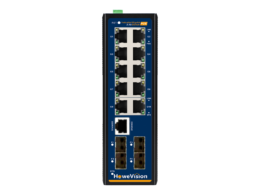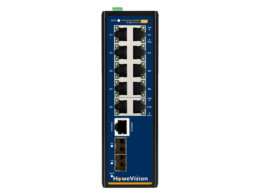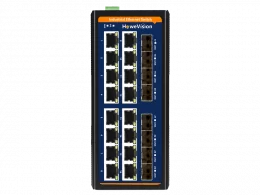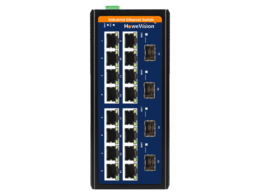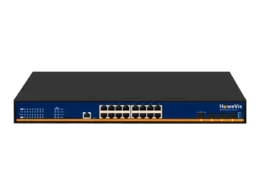Ever visited a factory? Many machines are out there, working synchronously—for example, a Coca-Cola drinks production company.
If you visit the factory, you can observe the synchronous integration and work of the device. The formation of bottle plastic, Coke drink formation, and plastic covering formation always happens at the exact moment. Seems to be sweet, right? Yes. It is. However, if you determine that the drink formation and packing occur without error,
Here arises the primary question: how is it even possible?
Many different protocols specify the changes and produce simultaneous Coke drinks. Let’s discuss one of those essential protocols, PTP. Here we will learn about the PTP protocol and understand the scenario.
What is a PTP Switch?
PTP switch, also called precision time protocol switch, is a bridge that connects the device, synchronizes them, and lets them work chronologically, another extraordinary phenomenon ahead.
PTP is not a simple switch; instead, it facilitates higher time accuracy. However, before understanding the PTP switch, we must catch the gist of the background story of PTP.
Background Story of Precision Time Protocol
It is not all about the Precision Time Protocol PTP. We also had other protocols, such as Network Time Protocol (NTP) and Simple Network Time Protocol (SNTP). Both these protocols are insufficient to synchronize the boundary clock and provide us with accuracy in the microseconds.
Later in 2002, the Institute of Electrical and Electronics Engineering(IEEE) introduced the first standard version of Precision Time Protocol (PTP), IEEE 1588-2002. Based on its defined principles, the PTP protocol gets the green light for its working mechanism.
The story doesn’t end here. We have two more versions of the PTP system. In 2008, IEEE improved the first standard and provided another version called IEEE 1588-2008. Unfortunately, this version is not backward compatible; you will be stuck in many serious problems then.
In November 2019, IEEE introduced another version of IEEE 1588-2019. Do you know what this standard is? It is BACKWARD COMPATIBLE, and you can use it with the PTP 2008 version.
So, what does a PTP switch do in the network?
It does nothing special except synchronize the device defined by the principles of IEEE 1588. The boundary clock is in multiple devices, and all the devices in the network are in chronological order.
How does it work?
We have learned a lot about PTP switches. Isn’t it complex(For me, it is)? Why not understand it in more detail? Yes. We can effectively keep the code in mind by understanding its working mechanism.
PTP’s working mechanism is not rocket science. A BIT TECHNICAL. A bit more efficient one. But we will learn about some problems such as delays.
PTP provides time synchronization between the devices in the Ethernet network. There are two types of clocks.
- Master Clock
- Slave Clock
The Master clock is the primary clock according to which the slave clocks set up their time. The master clock sends a message over the Ethernet network to the slave clocks.
Is it still confusing? Let’s get an example from real life.
If you must send an important message to your relative or friend on Monday, you do that. Do you think the post will reach your friend on the same day? I’m not sure; if the distance is longer, it might take one day or more. Suppose you sent the post on Monday, and the document reaches Wednesday. A two-day delay can be a problem. What if the friend already knows the time? It will successfully prevent the delay in implementing the critical message.
It is what the Precision Time Protocol PTP system believes. Since the master clock sends a message to the slave clock, it takes time to reach the news. So, DELAY occurs.
PTP sends the event message in a two-way exchange, from master to slave and slave to master clock. It provides an estimated ROUND TRIP DELAY time. PTP halves this time and gets the accurate delay value to cope with problematic situations of uncertainty.
What if the round trip delay time is different? It is an asymmetrical problem causing bizarre situations and might put various hurdles on the road.
How does the PTP reduce the delay time and increase synchronization in microseconds? I have the same question in my head. Let’s crack the code.
3 Methods to Reduce error in delay estimate
If given the opportunity, errors are pretty imminent. And our Ethernet network is doing that by delaying. However, there can be various problems with accurately estimating the delay when turning up the light for time synchronization.
Here are three core methods, which are super easy and accurate. Let’s walk through them.
Hardware Timestamping
Hardware Timestamping calculates the delay whenever the event message crosses the physical interface. The time for crossing essentializes the features of delay. No more delays or errors due to software!
Hardware Timestamping is a popular choice for network servers.
Boundary Clock
The boundary clock recovers when the messages reach the slave clocks. At some intermediate points during the transmission, forwarding gives us an accurate idea of the time, a vital feature of the boundary clock mechanism.
A boundary clock is available in an Ethernet network; your switches and routers contain a boundary clock.
You can prevent delays due to unknown reasons and calculate the time accurately.
Transparent Clock
You might have heard of a Transparent clock in the network. A transparent clock is present in:
- Ethernet switch
- Routers
A transparent clock works differently. Instead of calculating the time at intermediate points and forwarding the messages, they go into the root of time spent on sending the event messages from the master clock to the slave clock.
When the message arrives at the required clock, it contains the delay time and aids in clock synchronization.
5 Types of PTP clocks
Clock synchronization is a crucial feature in Ethernet networks. Since we are implementing time precision control, here are five clock types that must be adopted.
These are:
Grand Master Clock
The BOSS clock!
Grandmaster clocks derive their time from GNSS-driven clocks such as GALILEO, GPS, etc.
Boundary Clock
Versatile clock. An enslaver to its slaves and slave to its masters(It’s fantastic!). You can expect the time handling and synchronization to estimate delays in the Ethernet networks.
Ordinary Clock
An Ordinary clock!
It can be used as a master or a slave clock, thanks to the dual functionality of the watch.
Master Clock
No doubt a MASTER of all clocks!
It can work only as the master clock. It derives its time from the clock chain.
Transparent Clock
The super awesome role for time measurement.
A transparent clock calculates the time of the PTP event messages and helps set up the clock-in time measurement.
4 Applications of the PTP Switch
PTP switches provide various opportunities to synchronize the device and allow it to work at a specific time and pattern.
No delays. No more hurdles. Everything goes smoothly and flatly. PTP switch provides multiple applications, such as:
Generic Time-Stamping Applications
Time-stamp applications help record events according to the time and relevant events. Computers and online software can be Generic time-stamping applications. Their synchronization is essential to storing information, synchronizing data, and implementing the necessary procedures to ensure high-level communications.
IT applications
The IT department is a crucial application of the PTP switch. At IT centers, offices, and enterprises, multiple applications are running simultaneously. To control them and enable real-time communication, the PTP switch must be deployed.
Aircraft monitoring instruments
Pilots fly jets in the air and are always in communication with local airports to determine where to land them.
Moreover, the multiple tools in the Aircraft require synchronization to land at the airport. Therefore, we consider the PTP switches sending signals to other instruments. The coordinated movements of the devices will lead to the aircraft landing and taking off.
Therefore, Aircraft is a substantial application of the PTP switches.
Industrial Applications
In the whole article, I have discussed industrial machines. Can you guess why industrial applications only? These are ideal examples of synchronization to process the production of products, packing, and sending at the corner point.
Industrial devices also comprise Ethernet networks and employ the PTP switch for coordinated movements. This will help you better understand what we can call synchronization.
Just go ahead and observe the phenomenon. You will be amazed like I am.
3 Advantages of the PTP switch
PTP switch? Is there any advantage of this switch? How can it help us?
All these questions are common and relevant to the topic. The answers are crucial. I have listed three significant advantages of the PTP switch in our systems and Ethernet networks.
Accurate Time Stamping
PTP switch provides accurate time stamping. Is this even possible? Yes. We have several mechanisms to control the delay process, even if we can not measure the exact time. We can implement the time stamping mechanism to calculate the precise time in delay.
Accurate time stamping has many advantages:
- It helps set up our clocks, maintain the working time for the devices, and develop better synchronization facilities.
- Accurate time synchronization in the industrial zone maintains the manufacturing processes and provides the ultimate security.
- We can implement timing on our routers, allowing them to turn on and off when they are not in use anymore.
Accurate time stamping features of the PTP facilitate many applications in this way.
Intensified Security
Do you want to implement the ultimate security protocols at your location? It includes various problems. You must build a network and let the devices work efficiently and synchronously.
Time applications and proper synchronization let the system work according to time control. Whatever time you set, the devices will follow it. This will set up a better security system, where you will monitor all the machines in real time.
Synchronized Communications
Have you ever heard of real-time communications? These communications are like live television, where the satellite helps to capture pictures from different regions of the world and live stream them.
All Real-Time communications connect the devices over the network and help them build a high-coordination mechanism. You will observe the synchronized contacts, one performing on time after the command from the other.
So, what are the benefits of synchronized communications?
- They help machines work effectively in industrial zones. For example, if a device fails, other devices will act accordingly to turn it off to prevent any error in the production process.
- The overall failure risks are no longer in the system.
Final Words
What have you learned? PTP clocks, switches, Ethernet networks, right? All can be confusing if you are a first-time learner. Tighten your seat belt, grasp the fundamental principles, and implement the expert’s knowledge to understand PTP systems.
However, do you need Ethernet switches? If yes, no problem! We have that. For the past decade, HoweVision has been a top supplier for providing inventory related to:
If you need any of these, message us right away! We will help you get a free quote for your project.


